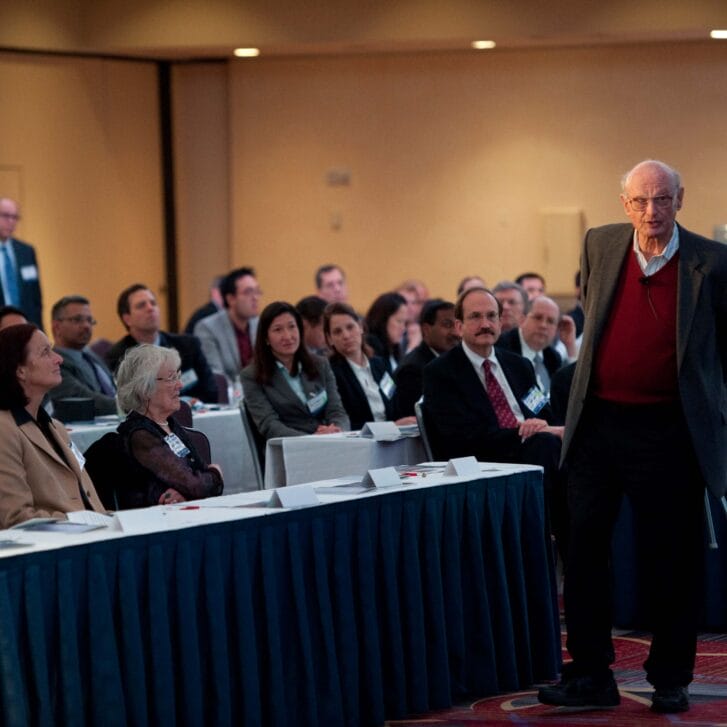The World Wide Web is rapidly becoming the World Wide Mall. But how will electronic markets evolve? What do they mean for traditional marketing? What are the most effective interfaces for selling? Wharton professors — expanding upon years of research in marketing, operations, public policy, and other areas — are studying and helping to shape the future of commerce online.
The Four P’s Meet the Internet
The “four P’s” — product, place, price, and promotion — have long been the cornerstone of marketing. Electronic commerce has fundamental implications for each of these elements of the “marketing mix,” according to a paper by Wharton Professor Jerry Wind and colleague Arvind Rangaswamy. The researchers examine forces shaping electronic markets and their impact on marketing and business strategy. Among their insights on the four P’s:
Product: Only certain types of products are likely to be successful online. “Search goods” such as airline tickets and office supplies, which are bought by comparison shopping without having to experience the product, are well suited for online sales. Products requiring extensive searching, such as baseball cards and other collectibles, are particularly well suited to sell online. Products that can be digitized — such as books or software — can be both marketed and distributed electronically.
Place: Electronic commerce flattens the distribution channel by connecting buyers directly with sellers. Retailers have traditionally served as intermediaries between customers and manufacturers, offering buyers more variety and reduced waiting time for products. Now, customers have access to more variety online. Shoppers Advantage, for example, offers 250,000 items online, whereas even the largest superstores only stock about 100,000. Electronic commerce also can make location irrelevant. Arctic Adventures, a small Norwegian travel agency, sold more than 100 travel packages to American tourists in its first year on the Internet — without advertising or a U.S. office.
Price: Because products by different manufacturers can be compared easily online, price becomes far more important. Price setting and price changes take only a few keystrokes, which should escalate the speed and intensity of price competition. Electronic markets also allow for highly flexible pricing policies (such as purchasing a chapter of a book rather than the full text).
Promotion: Because consumers who use electronic shopping services are actively seeking a product (compared with passive television viewers), advertising must also change. Advertising has to be unobtrusive, but also interactive. Advertisers know more about the customers receiving their messages, so they can create context-sensitive ads. The development of user groups and other electronic communities may decrease dependence on advertising as “word-of-mouth” information about products travels more quickly.
“Many marketing managers view these developments (in electronic commerce) as leading technologies, rather than in terms of what they really are — leading indicators of a transformation underway to fundamentally alter how various types of market exchanges occur in the future,” the authors write.
Arvind Rangaswamy and Jerry Wind, “Don’t Walk In, Just Log In! Electronic Markets and What They Mean for Marketing,” December 1994.
Why Computers Haven’t Taken Futures Traders Out of the Pit
The futures pit of the Chicago Mercantile Exchange is a shouting, seething mass of tens of thousands of traders who complete more than 550,000 contracts a day in a space of about 70,000 square feet. In contrast the electronic, automated counterpart of the exchange, GLOBEX, handles a mere 6,000 contracts daily.
Although electronic trading has become widely accepted in stock trading, it has not caught on in futures trading. This may be because stock trades depend on information about the companies traded while futures deals depend much more on expectations that are communicated through the activity on the floor itself.
The failure of the electronic system to gain wide acceptance “highlights some important interface design issues of the electronic system,” write Gerald L. Lohse, assistant professor of operations and information management, and Satu Parikh. In particular, the efficient, though frenetic, personal contact and communication that occur on the floor are lost in the electronic system. Shouts and hand signals are used to offer futures to the market. Traders often make decisions about which pits to trade in based on the noise level of the pit. The electronic system, using an order execution algorithm, provides less information about trading levels, and is less flexible in accepting and changing orders.
Lohse and Parikh propose a new interface that uses icons to represent each trader and shows standing bids or offers. Traders could click on the icon of other traders to “hit” the bids. In this way, the activity of the trading floor is more closely represented by the electronic version.
Satu S. Parikh and Gerald L. Lohse, “Electronic Futures Markets Versus Floor Trading: Implications for Interface Design,” May 1995.
Future Scenarios: Mr. Goodstore Meets 7-11 in Cyberspace
How will electronic commerce unfold in retailing? In discussions with dozens of senior executives in dry goods, packaged goods and service industries, Eric Clemons, professor of operations and information management, identified four key scenarios for the future of retailing:
– Looking for Mr. Goodstore: This is the traditional face-to-face, low-tech, high-touch shopping experience. Customers have sufficient disposable income and time to purchase their goods at the mall through traditional, non-wired interactions, sipping champagne while shopping for suits.
– Sears is My Shepherd, I Shall Not Change: Shoppers are more concerned with price and the efficiency of the shopping experience, but continue to shop in traditional face-to-face interactions. These consumers are not shopping for pleasure as in the Mr. Goodstore scenario; they either reject advanced technology or are loyal to stores such as Sears and are reluctant to change.
– 7-11 in Cyberspace: This is an ultra-efficient, ultra-convenient electronic alternative to conventional shopping through electronic home shopping. Shoppers will be able to fly down virtual aisles that are tailored to their shopping history or place their order Monday morning for “the usual Monday order.” These stores could undermine grocery stores and mass merchandisers. Current store operators are unlikely to be successful operators of the new virtual stores, which would require a different set of skills. Manufacturers may also suffer, because virtual store operators can easily add and remove items from the shelves, dropping the lowest-margin items and negotiating with manufacturers for discounts and overrides.
– Walden Pond Meets the Internet: In this scenario, consumers are less driven by efficiency than the “7-11 in Cyberspace” shoppers. They savor and enjoy the virtual shopping experience, “surfing” through products in a virtual mall. In this scenario, consumers benefit while efficient competition restricts profits for manufacturers and retailers.
Although the Mr. Goodstore scenario seems least likely to be the future of retailing, “this appears to be the official future embraced by many retailers, and the basis of much of their current short-term strategic positioning,” Clemons says.
The last two scenarios seem most likely, he says, as computers proliferate and the Internet and new interactive media spread. “There is no expectation that any one of these scenarios will prove to be ‘correct’; rather, all realized futures are expected to be a combination of two, three, or even all four scenarios,” Clemons writes.
Eric Clemons, “Future of Electronic Consumer Interaction in Retailing: Analysis of Competing Scenarios,” October 1995.

























